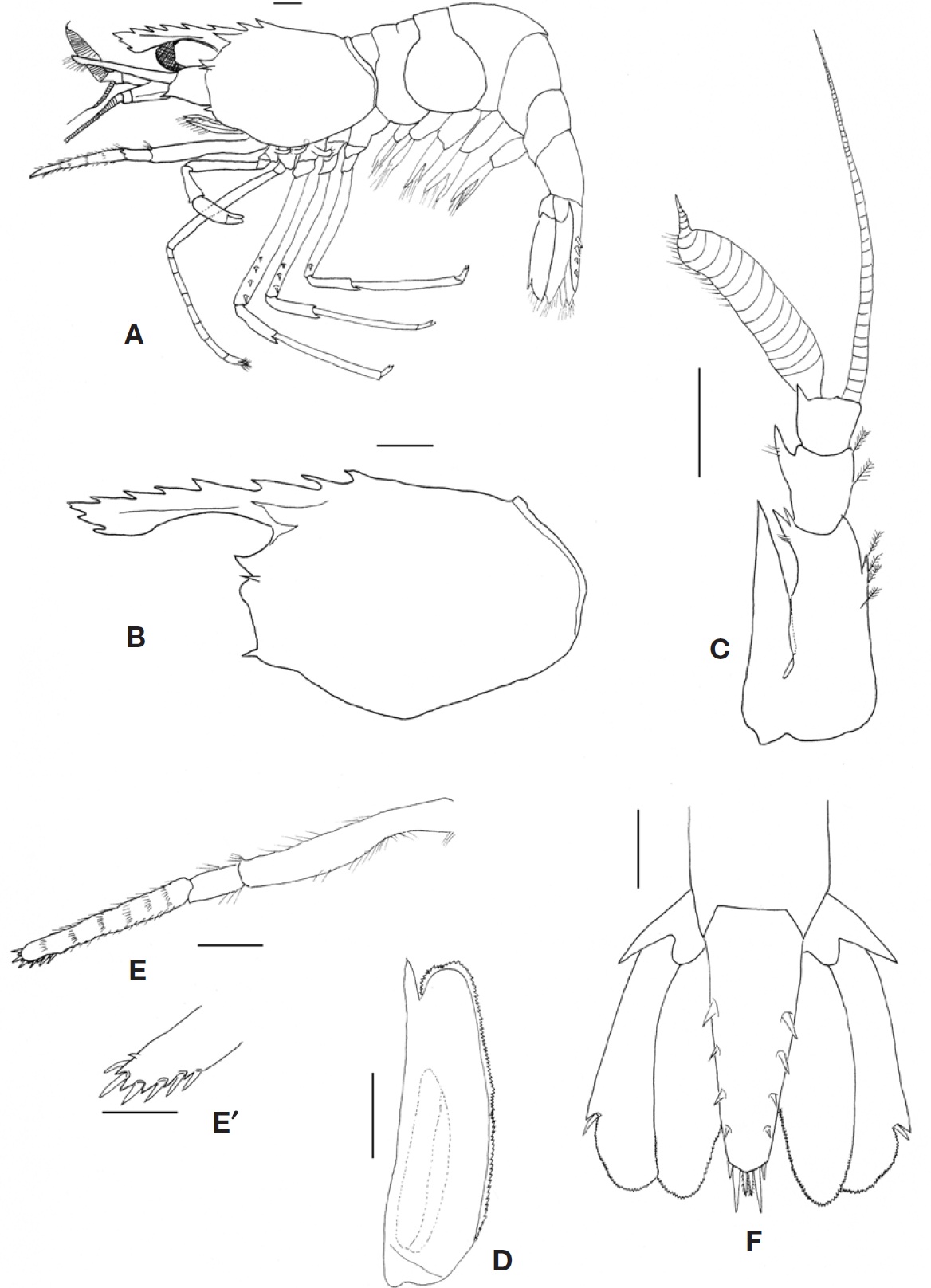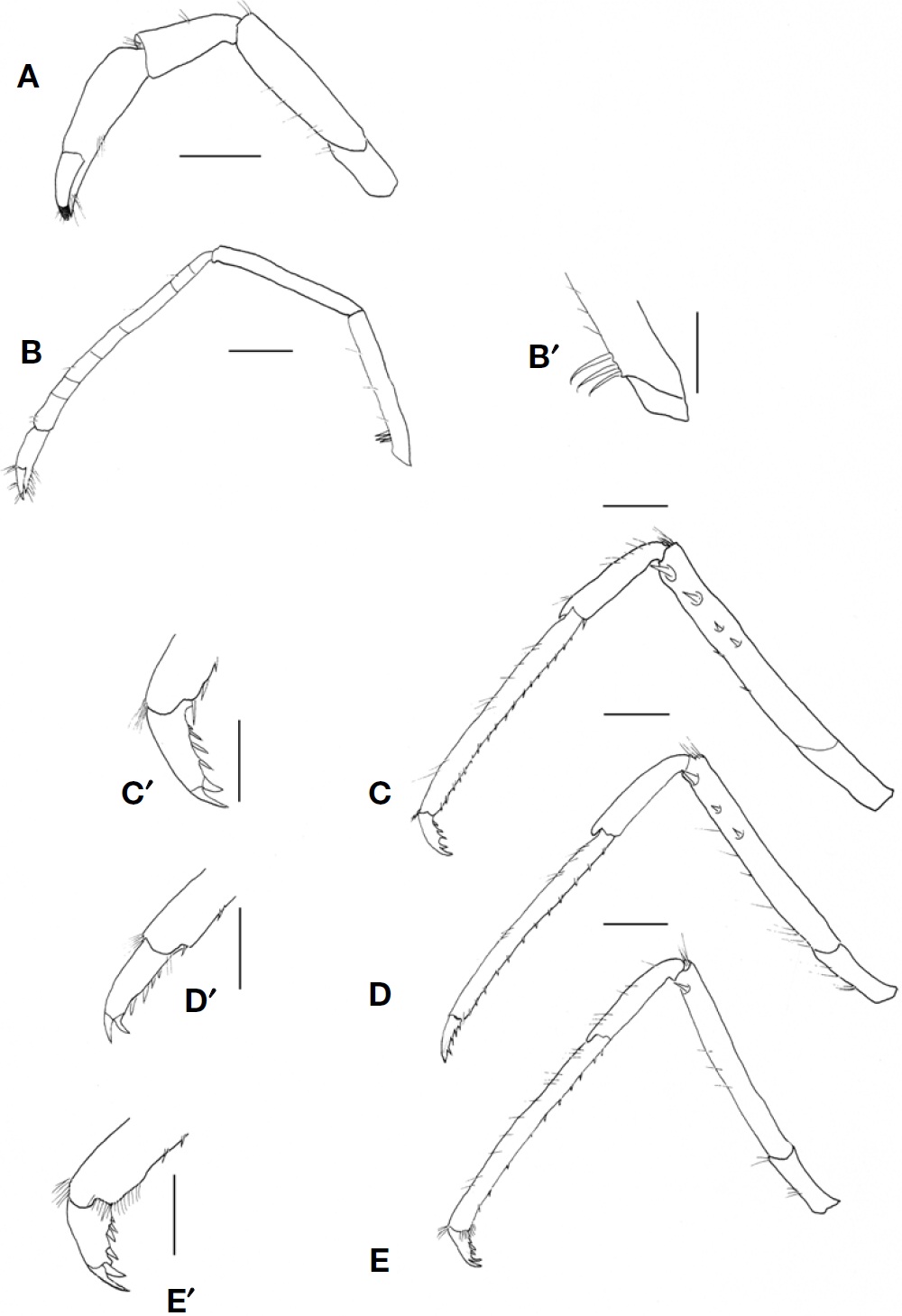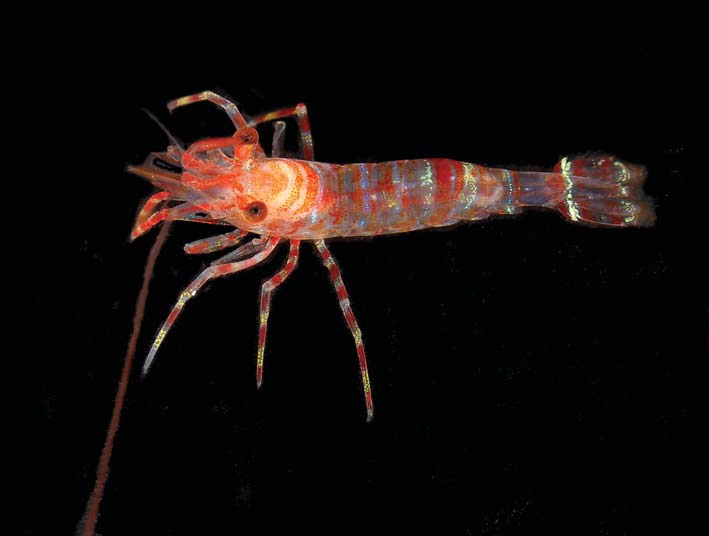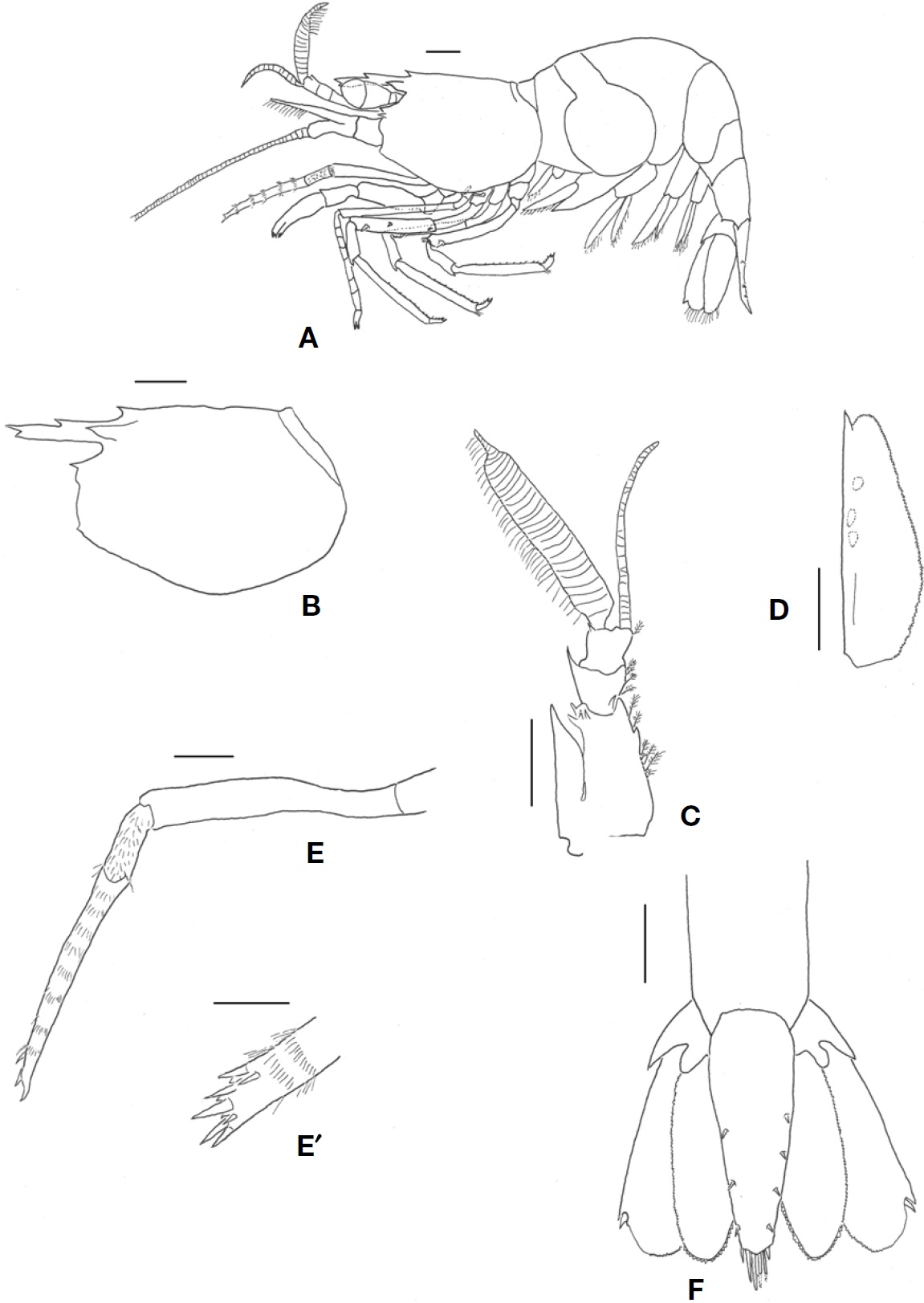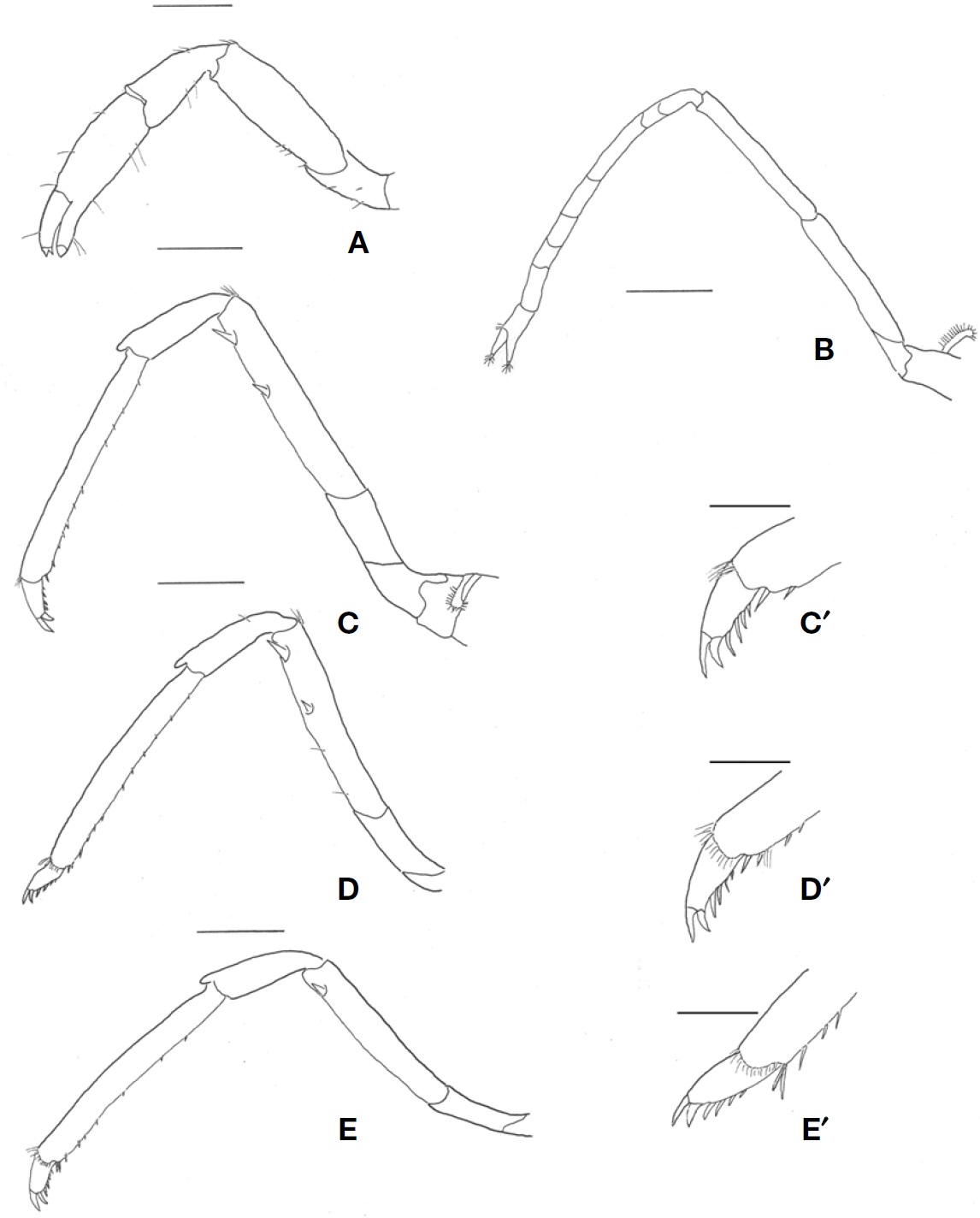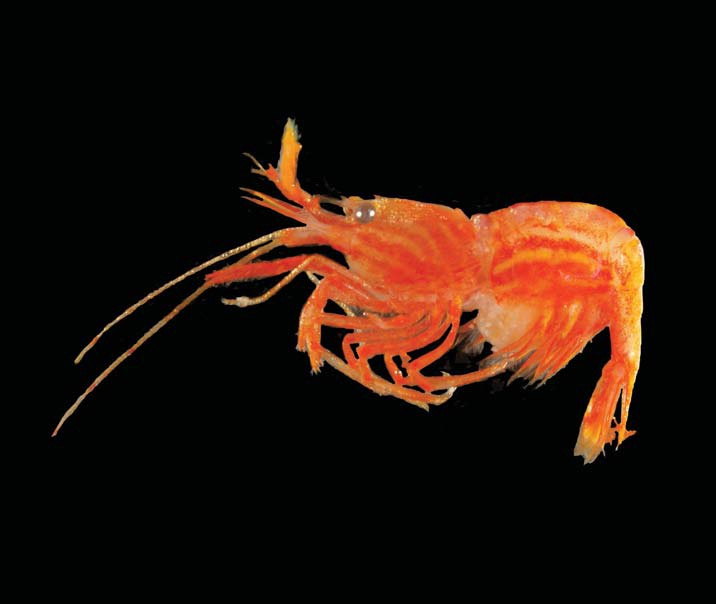



The hippolytid genus
Postorbital carapace length is abbreviated as “CL”. It is used as an indication of the size of the specimen, and is measured from the posterior margin of the orbit to the posterior mid-dorsal margin of the carapace. All specimens were preserved in 95% ethanol. Materials examined in this study are deposited in the second author’s collection of Silla University, Busan.
Order Decapoda Latreille, 1803
Family Hippolytidae Bate, 1888
Genus Lebbeus White, 1847
1*Lebbeus speciosus (Urita, 1942) (Figs. 1-3)
Material examined. 1♂ (CL 5.9 mm), Korea: Jumunjin, Gangneung, 31 Mar 2011, Lee SH, scallop farm.
Description. Small-sized body. Rostrum (Fig. 1A, B) straight,
exceeding distal margin of antennular peduncle, with 5 dorsal, 2 ventral teeth distally. Carapace (Fig. 1A, B) not carinate on mid-dorsal line, with 2 teeth on anterior one-thirds; supraorbital spine well-developed; antennal and pterygostomial spines acutely pointed. Abdomen (Fig. 1A) smooth dorsally; pleura of first and third somites rounded ventrally, those
of fourth and fifth somites pointed posteroventrally. Telson (Fig. 1A, F) 1.4 times as long as sixth abdominal somite, with 4 pairs of spines dorsolaterally; posterior margin with 3 pairs of unequally-sized spines. Eyes (Fig. 1A) cylindrical; eyestalk slightly longer than cornea. Antennular peduncle (Fig. 1C) short; first segment with 3 (1 sub-medially, 2 distolaterally) spines; stylocerite slightly exceeding distal margin of first segment; second segment twice as long as third one, with strong lateral spine on subdistal margin; third segment with smaller spine distolaterally; outer flagellum swollen, inner flagellum slender. Antennal scaphocerite (Fig. 1D) 3.0 times as long as broad; outer spine reaching distal margin of lamella. Third maxilliped (Fig. 1E, E′) long, exceeding antennal scaphocerite; distal segment 3.4 times as long as subdistal segment, with rows of transverse setae, with 12 (6 movable, 6 immovable) spinules near apex. First pereopod (Figs. 1A, 2A) moderately stout, reaching distal margin of antennal scaphocerite. Second pereopod (Figs. 1A, 2B, B′) slender, exceeding distal margin of antennal scaphocerite; ischium with 3 stiff setae proximally; carpus 7-articulated; chela small. Third pereopod (Figs. 1A, 2C, C′) exceeding distal margin of antennal scaphocerite; merus with 4 spines. Fourth pereopod (Figs. 1A, 2D, D′) reaching beyond antennal scaphocerite by length of dactylus; merus with 3 spines. Fifth pereopod (Figs. 1A, 2E, E′) slightly shorter than fourth pereopod; merus with 1 subterminal spine. Dactyli of last three pereopods (Fig. 2C′-E′) terminating in 2 claws, each with 4 spines on posterior margin.
Color. Body semitransparent, with red bands. White bands prominent on telson. Pale blue bands on abdomen. Pereopods with red and white bands (Fig. 3).
Distribution. Japan, Sakhalin, Siberia, Bering Island, California (Wicksten, 2011), and now Korea.
Remarks. This specimen generally agrees well with the description of Hayashi (1992), however, it slightly differs by having a rostrum with 2 ventral teeth, not 3 ventral teeth. This difference is maybe due to the much smaller size of our specimen (CL 5.9 mm) compared with that of Hayashi (CL 7.0 mm).
1*Lebbeus comanthi Hayashi and Okuno, 1997 (Figs. 4-6)
Material examined. 1♀ (CL 4.9 mm), Korea: Gampo, Gyeongju, 30 May 2012, Lee SH, by SCUBA diving to a depth of 15 m.
Description. Small-sized body. Rostrum (Fig. 4A, B) straight, not exceeding distal margin of first segment of antennular peduncle, with dorsal tooth medially, ventral tooth distally; apex acutely pointed. Carapace (Fig. 4A, B) smooth, with
tooth dorsoanterially; supraorbital spine strong, well-developed; antennal spine small, acutely pointed; pterygostomial spine minute. Abdomen (Fig. 4A) smooth dorsally; pleura of first four somites rounded ventrally; pleuron of fifth somite pointed posteroventrally; sixth abdominal somite 1.6 times as long as fifth somite. Telson (Fig. 4F) 1.5 times as long as
sixth somite, with 3 or 4 spines dorsolaterally; posterior margin with 3 pairs of unequally-sized spines. Eyes (Fig. 4A) cylindrical; eyestalk as long as cornea. Antennular peduncle (Fig. 4C) short; first segment with 5 (1 sub-medially, 4 distolaterally) spines; stylocerite reaching distal margin of first segment; second segment as long as third one, with strong spine distolaterally; third segment with small spine distolaterally; outer flagellum swollen, inner flagellum slender. Antennal scaphocerite (Fig. 4D) 3.1 times as long as broad; outer spine exceeding distal margin of lamella. Third maxilliped (Fig. 4A, E, E′) long, exceeding antennal scaphocerite; distal segment 3.0 times as long as subdistal segment, with rows of transverse setae, with 10 (7 movable, 3 immovable) spinules near apex. First pereopod (Figs. 4A, 5A) moderately stout, reaching distal margin of antennal scaphocerite. Second pereopod (Figs. 4A, 5B) slender, exceeding distal margin of antennal scaphocerite; merus unarmed; carpus 7-articulated; chela small. Third pereopod (Figs. 4A, 5C, C′) exceeding distal margin of antennal scaphocerite by length of dactylus; merus with 2 spines. Fourth pereopod (Figs. 4A, 5D, D′) reaching distal margin of antennal scaphocerite, merus with 2 spines. Fifth pereopod (Figs. 4A, 5E, E′) as long as fourth pereopod; merus with 1 spine. First three pereopods with epipods; dactyli of last three pereopods (Fig. 5C′-E′) terminating in 2 claws, each with 4 spines on posterior margin.
Color. Body semitransparent; red and yellow bands obliquely on carapace, longitudinally on abdomen. Pereopods and pleopods red (Fig. 6).
Distribution. Japan (Hayashi and Okuno, 1997) and now Korea.
Remarks. This specimen generally agrees well with the original description of Hayashi and Okuno (1997), However, it slightly differs from the Hayashi and Okuno’s specimen in that a pleuron of the fourth abdominal somite is rounded posteriorly. The shape of the fourth abdominal somite has been considered to be a diagnostic character in species of
Currently, six
Korean name: 1*색동가시배새우 (신칭)
Korean name: 1*갯고사리새우 (신칭)

